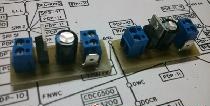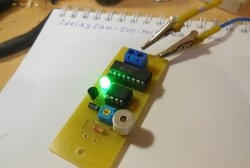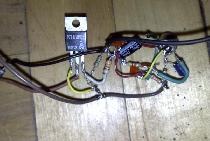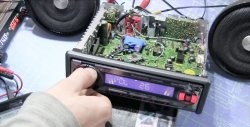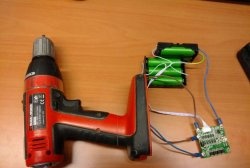
Hello friends. Today I want to tell you and show you my homemade product that uses voice control. It's actually a voice controlled on/off switch. The peculiarity of this homemade product is that this device can not only control the load by voice command, but can also respond with voice commands previously recorded on a flash card.
In appearance, the device turned out to be so nondescript. It's my fault, but I didn't set myself the goal of making it beautiful, I was just lazy. Actually, for the same reason, I brought out a minimum of devices for controlling this device, of which on the front panel there is only a volume control knob for the transponder and a flash card receiver, which at first I also wanted to stuff inside.
What can this switch do? It can switch off 3 loads independently of each other. It works as follows: in the switch I organized increased noise immunity from unwanted switching on. This is expressed in the fact that to turn off the required load, you must first contact the device.
To contact, you must say “Arduino”.I called it that because the heart of this device is the voice module, which we will get to know in the future, and was intended primarily for the Arduino designer. Although I have never encountered Arduino and its modules are not used in this device.
We turn to the Arduino switch, if the switch responds “Listen”, then say the following of the three commands assigned by me: “Lamp”, “Garland”, “Light”. After accepting the command, the device will switch the state of the connected device to the opposite: if the lamp was on, it will turn off, if it was not on, it will turn on. And he will answer, for example: “The lamp is off” or “The lamp is on”...
Simply put, our dialogue with the switch will be as follows:
- Arduino.
- I'm listening.
- Light.
- I turn on the light.
It was, of course, possible to program the module with specific commands: “Turn on the light”, “Turn off the light”, but I decided to make it so that one command would turn it on and off.
I recorded all the answers on a flash card. These are regular WAV files. The text was read by an English translation site. This could be any other program that can read text. Or, in general, you or your relatives can write down these answers...
I don’t know whether this is a plus or a minus, but this device is sensitive to voice timbre. That is, for example, he disdained my wife until I separately recorded her voice on the module. And I gave her different answers: a woman answers me, and a man answers her. Cool, isn't it?)
Well, now let's finally move on to testing this device. We plug it into the network and connect one load.
You need to wait about 5 seconds until the module itself boots up, while the controller accesses the module, while the player initializes the flash drive and the files on it...
Watch the video below of the work process...
This is how this switch works. Now let's look at the inside of the switch. Remove the top cover. The first player board with an amplifier. It is she who reproduces the answers recorded on the flash drive. The board is controlled using the UART protocol. The commands are sent by the controller located on the second board, which we will return to a little later. Next, the third board - a power supply with power switches - was made in the semesters. The entire circuit is galvanically isolated in voltage. The board is also controlled by a controller. The power supply produces 5 volts of stabilized voltage. Power switches can withstand a load of about 200 W per channel. Now let's move on to the second board. There is a controller on it that controls everything and a voice command recognition module.
We will look at the operation, connection and configuration of the module in the next video. And now I will explain the operation of the controller, which is made on atmega8. The module that recognizes the command gives a command to the controller via UART, the controller, having processed the command, turns the load on or off and commands the sound module to play an audio response. Everything seems simple).
I want to say that when making this homemade product, I did not set myself the task of making a serious device, rather a toy.
In the next video you will look directly at the module itself, so subscribe to the channel so as not to miss it, if of course this material interests you.
I built this switch a couple of years ago using a V2 module. But in the next video we will look at the newer version V3. We will also consider 2 types of work with this module: simple - this is if you do not know programming and full - this is if you know how to program microcontrollers.
Voice recognition module V3 -
Voice recognition module V2 -
I hope you enjoyed the video on this topic. Thanks for watching this video. If you liked it, give it a like, so I will know that you care. Subscribe to the channel, see you next time.



